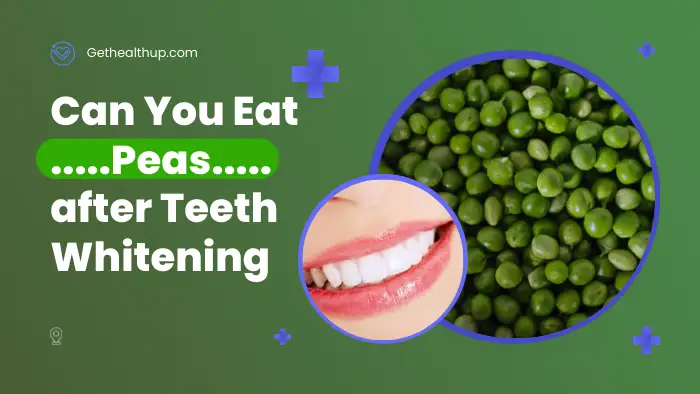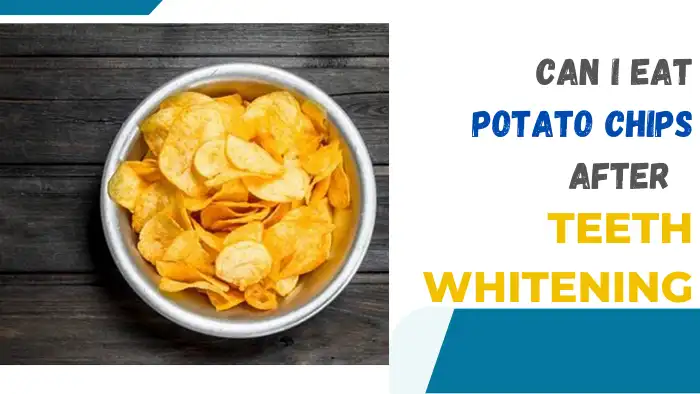Yes, you can eat peas after teeth whitening. However, it’s recommended to avoid consuming any food or drinks that can stain your teeth for at least 48 hours after the treatment.
This includes foods and drinks such as coffee, tea, red wine, tomato sauce, berries, and dark-colored sodas.
Peas are not likely to stain your teeth, so they should be safe to consume after teeth whitening.
However, it’s important to remember to practice good oral hygiene habits after eating any food, including peas.
Be sure to brush and floss your teeth regularly to maintain your newly whitened smile.
The Effect of Peas on Newly Whitened Teeth

Peas are a healthy source of nutrients, but they can potentially stain newly whitened teeth due to their deep green color.
The pigments in peas can stick to the teeth’s surface, causing discoloration.
To prevent this, it’s best to wait at least 24 hours after teeth whitening before consuming peas or other foods that may stain the teeth.
Additionally, it’s essential to brush and floss regularly to maintain the teeth’s whiteness.
PROS
- Soft texture: Peas are a soft and tender food, which makes them easy to eat after teeth whitening. They won’t put pressure on your teeth or cause discomfort.
- Nutritious: Peas are packed with nutrients, including vitamins, minerals, and fiber. Eating peas after teeth whitening is a great way to nourish your body while avoiding hard or crunchy foods that could damage your newly whitened teeth.
- Low in acid: Acidic foods and drinks can weaken your tooth enamel and make your teeth more susceptible to staining. Peas are low in acid, so they won’t harm your teeth or undo your whitening results.
- Low in sugar: High-sugar foods and drinks can contribute to tooth decay and discoloration. Peas are low in sugar, making them a tooth-friendly snack option.
- Easy to prepare: Peas are quick and easy to prepare, whether you steam them, boil them, or microwave them. This makes them a convenient snack to have on hand after your teeth whitening procedure.
Tips for Safely Eating Peas after Teeth Whitening
To avoid staining newly whitened teeth when consuming peas, it’s recommended to eat them with a fork or spoon, minimizing contact with the teeth’ surface.
Chewing peas thoroughly and swallowing them quickly also reduces the risk of staining.
Drinking water while eating can help wash away any pigments that may adhere to the teeth.
It’s essential to maintain good oral hygiene habits after teeth whitening, including brushing and flossing regularly and visiting the dentist for regular checkups.
The Importance of Aftercare
After teeth whitening, it is important to take care of your teeth to maintain the results.
The teeth are more susceptible to staining immediately after the procedure, so it is essential to avoid certain foods and drinks for a certain period.
Additionally, proper oral hygiene practices such as brushing and flossing regularly can help prolong the results.
Alternatives To Peas In Your Diet

- Green Beans: These crunchy veggies are packed with vitamins and minerals, making them a great alternative to peas. Plus, their mild flavor makes them easy on sensitive teeth.
- Broccoli: Not only is broccoli high in fiber, but it’s also rich in antioxidants that can help keep your teeth healthy and white. Steamed or roasted, this versatile vegetable is sure to satisfy.
- Spinach: This leafy green is not only good for overall health but also gentle on the teeth due to its soft texture when cooked. Add it to salads or sauté it as a side dish for a tooth-friendly alternative.
- Asparagus: Another tooth-friendly option, asparagus contains folate and other nutrients that promote oral health while adding variety to your plate.
- Cauliflower: With its mild taste and versatile nature, cauliflower can be used as a substitute for peas in many recipes.
Foods that are Safe to Eat after Teeth Whitening
While there are certain foods and drinks to avoid after teeth whitening, there are also foods that are safe to eat. These include:
Soft foods
Soft foods such as mashed potatoes, cooked vegetables, and soups are gentle on the teeth and can be easily consumed after teeth whitening.
White-colored foods
White-colored foods such as chicken, fish, and rice are less likely to stain the teeth and are safe to eat after teeth whitening.
Neutral pH foods
Neutral pH foods such as bananas, milk, and plain yogurt are less likely to damage the tooth enamel and are safe to consume after teeth whitening.
It is important to note that while these foods are safe to eat after teeth whitening, it is still important to maintain proper oral hygiene practices to ensure the results last as long as possible.
Tips for Protecting Your Newly Whitened Teeth
- Maintaining Good Oral Hygiene
- Using a Straw when Drinking
- Avoiding Smoking and Tobacco Products
- Regular Dental Checkups
Conclusion
It is advisable to avoid consuming peas after teeth whitening, as they can potentially stain your teeth and undo the effects of the whitening treatment.
It’s best to wait at least 24–48 hours before consuming any food or drinks that may stain your teeth.
Additionally, maintaining good oral hygiene habits can help prolong the results of your teeth whitening treatment.
Frequently Asked Questions
How long should I wait before eating peas after teeth whitening?
You should wait at least 24-48 hours before eating any solid foods, including peas, after teeth whitening.
Can eating peas after teeth whitening cause staining?
Peas are generally safe to eat after teeth whitening, but you should still be careful to avoid any foods or drinks that could cause staining.
Should I avoid peas altogether after teeth whitening?
No, you don’t have to avoid peas altogether. Just make sure they are cooked until they are soft and avoid eating them if they are too hot.
Can I eat peas immediately after teeth whitening?
It is generally recommended to avoid consuming any food or drinks for at least 30 minutes after teeth whitening, including peas.
Can I eat peas on the same day as teeth whitening?
Yes, you can eat peas on the same day as teeth whitening, but it’s best to wait at least 30 minutes to an hour to avoid any potential staining.
Will eating peas affect my teeth whitening results?
Peas themselves are unlikely to affect your teeth whitening results. However, if the peas are heavily seasoned or contain sauces that are highly pigmented, they could potentially cause staining.
How soon after teeth whitening can I eat peas soup?
It’s best to wait at least 24 hours after teeth whitening before consuming any hot or spicy foods, including pea soup. This will allow your teeth to fully settle and reduce any sensitivity.
Should I avoid eating peas after teeth whitening altogether?
No, you don’t have to avoid eating peas altogether after teeth whitening. Just be mindful of any heavily seasoned or pigmented pea dishes and avoid consuming them immediately after your teeth whitening session.
Are there any alternatives to peas that won’t affect my teeth whitening?
If you’re looking for crunchy and healthy options while protecting your newly brightened smile, consider incorporating other veggies into your meals. Carrots, celery sticks, and cucumber slices are excellent choices as they have a high water content and can even help cleanse your teeth naturally.
Does eating peas have any dental health benefits?
Despite their small size, green peas pack quite a punch when it comes to nutritional value! They are rich in vitamins C and K as well as dietary fiber which supports overall oral health by promoting gum health and reducing inflammation in the mouth.
How long should I wait before eating vegetables after getting my teeth whitened?
While the exact waiting time can vary depending on individual circumstances and the type of treatment you received, it is generally advisable to give yourself at least 24-48 hours before reintroducing vegetables into your post-whitening diet. This allows ample time for the tooth enamel to settle and reduces the risk of potential staining.

A Blogger, Author and Researcher! Gohar Aalam is recognized as a full-time blogger for Health and Tech Niches. I’m a Fountainhead of Gethealthup.com, will provides high quality knowledge.









